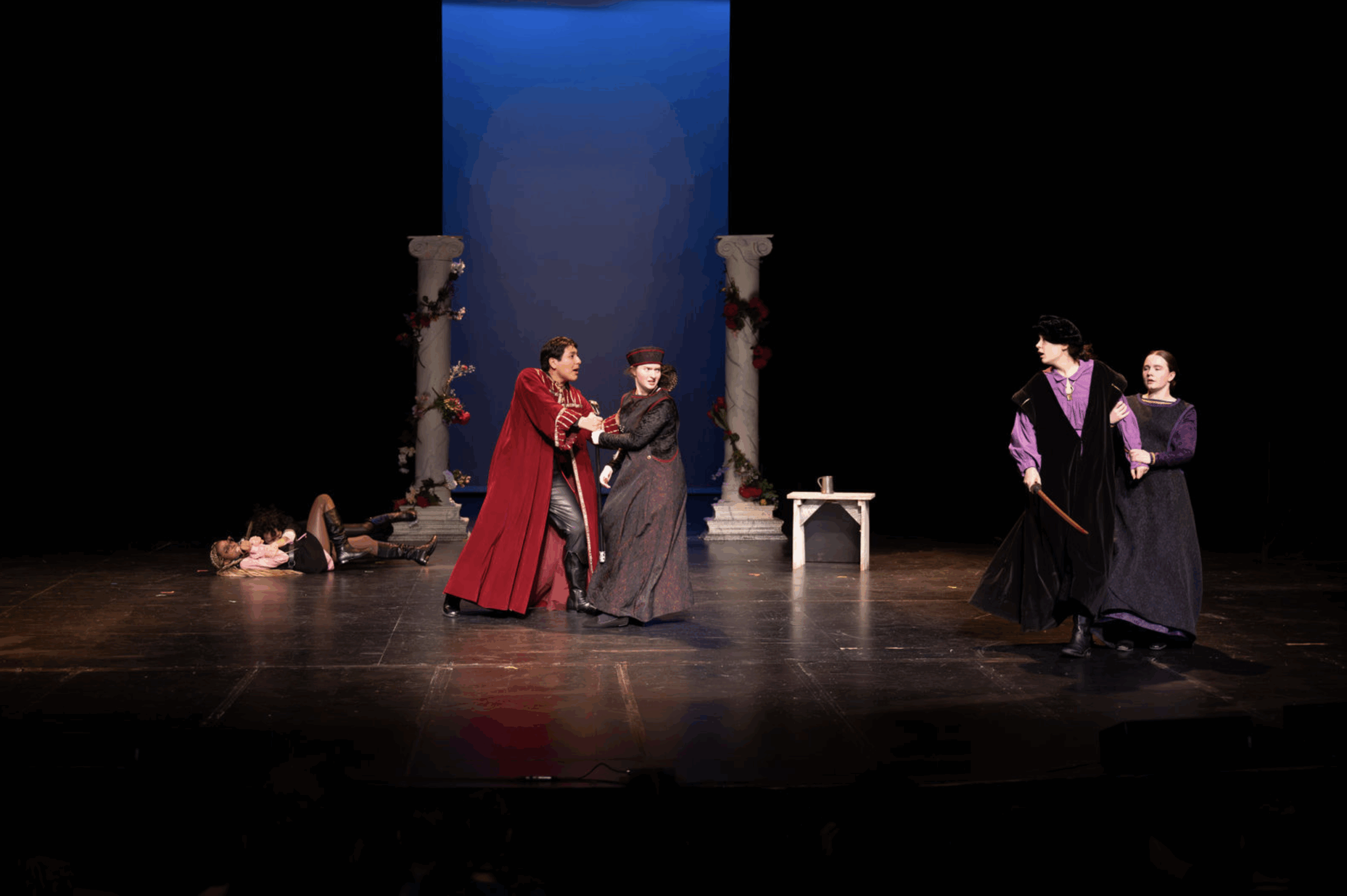
Summer approaches New Haven. Cherry blossoms grow, banners decorate Downtown lamp posts, and a peculiar wooden structure emerges amid a blanket of new green. For the thirtieth consecutive year, Edgerton Park transforms into an immersive theater. Long-time spectators know the drill: they know to pack their picnic baskets and to bring blankets for front row seats, chairs for the back. They know to throw their voice into the exuberance of the night’s crowd. They know they are welcome. The artists behind this operation come from the Elm Shakespeare Company. A storied New Haven cultural establishment, this theater company transforms the Bard’s famed plays into precisely designed and accessible modern productions, provides robust education programs for local creative students, and strengthens the New Haven community by making an extraordinary new world. In it, everyone is a creator.
The Work: Reinterpreting Shakespeare
It takes almost eight months for the Elm Shakespeare Company to bring their summer Shakespeare In the Park production to life. Rebecca Goodheart, the company’s Producing Artistic Director, kicks off the process at the turn of the new year. Deep in the thick of this year’s audition cycle, she squeezed in our February interview between a packed schedule of commitments. She even had to postpone by twenty minutes when a few kids from her after-school program stayed late to pepper her with questions. That week alone, she was gearing up to see as many as three hundred auditions — ultimately selecting just sixteen actors for the show.
“My job is an odd one,” Goodheart told me. She likes to call herself a “two headed monster.” As an artistic director, she dreams up infinite creative possibilities, but as a producer she understands the limits on what the company has capacity to achieve. It is precisely Goodheart’s understanding of the Elm Shakespeare’s physical and financial capabilities that allows her to take risks — to “swing for the fences.”
Goodheart’s emphasis on creative risk taking means that her plays are pointedly unconventional. She fashions the In the Park shows to direct the audience’s attention to specific themes and ideas that interest her from the chosen play. Her team’s job is to embed those themes into every detail of their production design, from precise historical setting to mood lighting and soundscape. A few years ago, the design staff adorned the summer stage with a massive wrought iron gate and an open air tent, draped with fairy lights and topped with a statue of Cupid. This was Love’s Labour’s Lost set on the brink of the First World War. Because Goodheart wished to highlight the increasing complexity of the play’s world, she set it in a time of global transformation into modernity. Another summer, the park stage became a canvas for pastel tones, whimsical buildings, and Dr. Seuss’s Truffula Trees. The show was The Comedy of Errors. The play’s storybook setting, familiar and comforting to the audience, propelled them to watch for the simple morals — like those that come at the end of a children’s book — that might have otherwise been shrouded in the chaos of a comedy filled with mistaken identities and ironic emotion.
Goodheart strays from Shakespeare’s classical visions in this way so that the audience may connect more deeply with the work. She believes — as does Elm Shakespeare — that these plays are only timeless if they are accessible. Thus, Goodheart considers how to relate the script to her perception of the current New Haven community and the state of the world before translating it into a play’s staging. “What are the stories that need to be told right now?” she asks herself. Those stories that she finds most relevant to her contemporary and local audiences are the ones Goodheart carefully crafts her productions to accentuate.
The Place: Dispersed in the City
The Elm Shakespeare Company is decidedly a New Haven institution. Not only does it draw in a diversity of local artists and audiences, but it is also physically present all over the city. Without a permanent facility, Elm Shakespeare is what Director of Development Alice-Anne Harwood calls an “itinerant company”. Its home base shifts as its productions do. Groups of staff take residence in theaters across town for each season’s smaller shows, reaching all corners of the city. Sometimes, the company performs out of Yale’s Schwarzman Center or in the Humanities Quadrangle. The more tangible spaces they occupy, the more people will have the chance to discover and interact with their art. Elm Shakespeare quietly integrates into the New Haven people’s idea of their city because it operates where those people can see.
Another key way The Elm Shakespeare Company physically immerses in the New Haven community is by working in its schools. From summer camps to after-school programs to classes within the school day, Elm Shakespeare’s education branch teaches New Haven students of all ages, guiding young performers to put on their own shows at school. This instruction is done using a pedagogy specifically designed to align with the company’s broader mission. Even its youngest participants are invited into Elm Shakespeare’s creative culture.
Education Director Sarah Bowles added that the company’s teachers invite participants to “embody the text,” to learn their plays and make them their own. Under this model, children and teens are respected as creators. And when they feel that their imagination and presence is important, they can take the risk to engage with maximum enthusiasm. Bowles told me about a kid she taught several years ago who was obsessed with becoming a rapper. He spoke his lines from A Midsummer Night’s Dream all in rap verses, interpreting Shakespeare’s words with rhythms from the hip-hop he loved. Without losing reverence for the theater tradition they are passing on, Elm Shakespeare teachers embrace students’ quirks, considering earnestly how they can be incorporated into performances. When students take the lead in interpreting their character, the performances are authentic in both content and emotion.
Bowles beamed as she began to tell me about the biggest event of the year for the youth programs she oversees: the annual Elm Shakespeare Company Youth Festival. Inaugurated two years ago, the December festival comprises a series of performances from high school students who have participated in Elm Shakespeare programs throughout the year. Bowles described how special it was to see the kids’ reactions to each others’ plays, the entire crowd cheering at the top of their lungs. Director Harwood herself even cried when she saw a teenage girl’s tears over another school’s production of “Romeo and Juliet”. The student had only met the performers that day, yet their art moved her deeply. By facilitating that kind of profound experience for students through the youth festival, Elm Shakespeare invites a new generation of voices into the New Haven arts scene.
Bowles deemed the ESC’s Youth Festival a “vacation from competition”. With so many rankings and grades thrown at high schoolers, participation in Elm Shakespeare provides a rare chance to celebrate their peers’ successes as their own. “They got it instantly”, Bowles said. The entire focus of the festival is joy and congratulation. By putting its values of inclusivity and connection at the forefront of its projects — and ensuring that those projects take place immersed in its home community — the Elm Shakespeare Company creates a zone of safety from what can be a harsh world outside.
The People: Weavers of Art
If Elm Shakespeare’s mission is to reproduce Shakespeare for and with the voices of the New Haven Community — to be “weavers” of their art, as Goodheart puts it — then the people who attend their performances are essential. They form that very body of voices. Goodheart says that “we are responsive to our community” and “there isn’t a fourth wall”. The company’s In the Park performances take place nowhere but the vibrant landscape of Edgerton Park, sprawling between Whitney Avenue and Edgehill Road. Each new crowd of spectators is unique to that night. Those shows belong to them alone.
For the final half hour before each In the Park show begins, the actors come on stage and sing with the audience. As the sun sets and clear blue twilight falls into place, the settling crowd enjoys acoustic music and smiling faces from the same people they will soon see transform into completely different characters. They get a glimpse of the performers’ humanity, their similarity to themselves. They get to join in the fun. This way, too, little kids who aren’t ready to stay up past their bedtimes can participate. Goodheart recalls seeing a family bring their tiny little girls to dance to their hearts’ content. When the music faded, they went back home. As the years have passed, she sees them now every summer, old enough to stay for the whole play and giddy every minute of it. Other families include parents who attended summer shows thirty years ago and have started to bring their own children. Not everyone packs a picnic, nor can everyone bring a loved one. But each patron brings their heart in anticipation of magic to come.
Then, the music dies down. The actors pick up their instruments and slip calmly behind a sweeping curtain. The buzz of excitement continues for a few minutes, and then the crowd’s whispering fades. The spotlights flash on, pinpointing the focus straight ahead. And all is still; everyone inhales, waiting, ready. Somewhere out of view, the stage manager whispers “places!” and the opening speaker awaits their cue. I imagine that as the silent moments pass, a viewer’s laser focus lapses briefly because they can’t help it. Their mind has begun to wander because they are imagining the possibilities. They are dreaming up the incoming world, where everyone all around is safe in each other’s art and passion. Where, as Goodheart puts it best, “love changes things”. They imagine their own place in that world; they are sure of it. That is Elm Shakespeare.




No Comment! Be the first one.